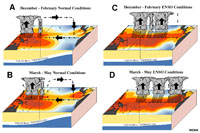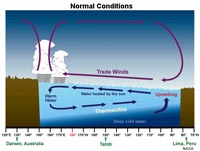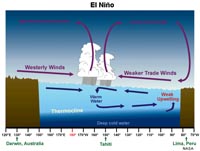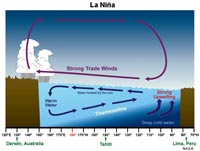9.11: El Niño/Southern Oscillation (ENSO)
- Page ID
- 10290
El Niño/Southern Oscillation (ENSO)
El Niño/Southern Oscillation (ENSO) in the Pacific Ocean [also called El Niño-La Niña Cycles] is associated with a band of warm ocean water that develops in the central and east-central equatorial Pacific. El Niño/Southern Oscillation (ENSO) is perhaps the most important ocean-atmosphere interaction phenomenon to cause cyclic global climate variability. Here's how the ENSO cycle works: ENSO involves the interactions of ocean currents, ocean temperatures, and atmospheric effects, over time.
Pacific Ocean Currents Involved With ENSO
- West moving winds at the Equator help to drive the two Pacific Subtropical Gyres (northern and southern gyres)(see Figures 9-6).
- In the North Pacific Subtropical Gyre, the western-intensified Kuroshio Current moves up the Asian seaboard (warming China, Japan), flows east with the North Pacific Current, then south as the California Current along the west coast of North America.
- In the South Pacific Subtropical Gyre, the western intensified East Australian Current moves south and merges with the Antarctic Circumpolar Current, the completes the gyre as the Peru Current (flowing northward along the west coast of South America).
ENSO Ocean Temperature Effects
ENSO Cycles are influenced by ocean surface temperatures throughout the Equatorial Pacific Ocean region. During the El Niño periods, ocean surface temperatures are much warmer than the La Niña periods. This is a reflection of the amount of cloud cover (deflecting incoming solar radiation) and winds driving cold upwelling currents to the ocean surface in the equatorial region. During El Niño periods, the Pacific Warm Pool grows larger and more intense in the Eastern Pacific region near Australia and Indonesia (Figure 9.24).

Figure 9.24. Ocean surface temperatures reveal the changing patterns and regional extent of the Pacific warm pool associated with El Niño-La Niña Cycles.
ENSO Weather Effects And the Walker Cell
• The rising warm-moist air in the western Pacific contrasts with the cool sinking air along South America, resulting in the Walker Cell (an unstable equatorial air circulation pattern region in the Pacific Ocean)(Figure 9.25). The Walker Cell operates perpendicular (east to west, not north to south like the Hadley, Farrell, and Polar circulation cells [see Figure 15.15]). the intensity Walker Cell weather pattern is controlled by temperature contrasts on opposite sides of the Pacific Basin along the equator.

Figure 9.25. El Niño-La Niña Cycles changes in the Walker Cell wind currents affect ocean surface temperatures which impact the thickness and extent of the thermocline (which impacts upwelling).
Under normal year ENSO conditions (which is actually rare) cool water conditions persist along the west coast of South America (Peru) (Figure 9.26):
• Trade winds blow to the west allow waters to upwell along the west coast of South America (some of the most productive waters in the world).
• West-moving winds drive surface currents westward across the Pacific Ocean where they heat up creating the Pacific Warm Pool - a thick thermocline in the western Pacific Ocean.
Under El Niño (the warm phase of ENSO) wind intensity of the Walker Cell circulation is diminished (Figure 9.27). El Niño is associated with high air pressure in the western Pacific and low air pressure in the eastern Pacific.
La Niña (the cool phase of ENSO) is associated with below average surface water temperatures and high air pressures in the eastern Pacific and low air pressures in western Pacific (Figure 9.28). Air circulation in the Walker Cell is intensified.
El Niño/La Niña Global Climate Impacts—NOAA videos, websites, animations
Warm El Niño Southern Oscillation (ENSO)- Episodes in the Tropical Pacific
El Niño/La Niña Explained (YouTube video).
NOAA's El Niño website.
El Niño/La Niña 1997-1998 (NOAA) - Shows sea surface temperature time lapse.
Global Sea Surface Temperature time lapse showing El Niño/La Niña (NOAA)





